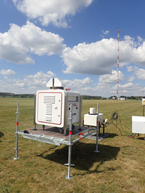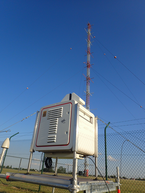
Measurement with Doppler lidar systems to derive profile information on wind and turbulence in the Atmospheric Boundary Layer (ABL) are planned as a core contribution to FESSTVaL. Instead of operating Doppler lidars at different sites around Lindenberg (as planned for FESSTVaL) measurements with eight Doppler lidar systems will be performed at the boundary layer field site (GM) Falkenberg between June 01, and August 31, 2020. In addition to the two DWD instruments, two co-operation partners (KIT Campus Alpin Garmisch-Partenkirchen and the Institute for Atmospheric Physics of DLR Oberpfaffenhofen) have brought each three Doppler lidars to Falkenberg. Moreover, in July it is planned to perform additional measurements with remotely piloted, unmanned aerial vehicles (UAV). All these measurements shall pursue the following goals:
- Comparison of different Doppler lidar scan configurations to derive profiles of the mean wind vector and of the turbulent kinetic energy among each other and versus in-situ measurements at the 99m tower,
- Validation of Doppler lidar wind and turbulence retrievals by UAV measurements,
- Test and assessment of different scan configurations to derive and to characterize wind gusts from Doppler lidar measurements,
- Characterization of the diurnal cycle of the three-dimensional wind and turbulence fields in the ABL above a heterogeneous land surface.
To achieve these goals, the Doppler lidar systems are operated in a number of different scan configurations (e.g. „vertical stare“, „virtual tower“, continuous and step-stare conical scan, horizontal / vertical sector scans <PPI, RHI>). Studies into the last question will be supported by measurements of the components of the surface energy budget above the grass at GM Falkenberg and above a neighbouring corn field.
Data
A look at the measurement data that accumulates daily during FESST @ MOL can be taken on the quicklooks page.
Data from another microwave radiometer can be found on the website of the University of Cologne (Brightness temperature, Liquid Water Path, Integrated Water Vapor, Temperature and Humidity profiles)




